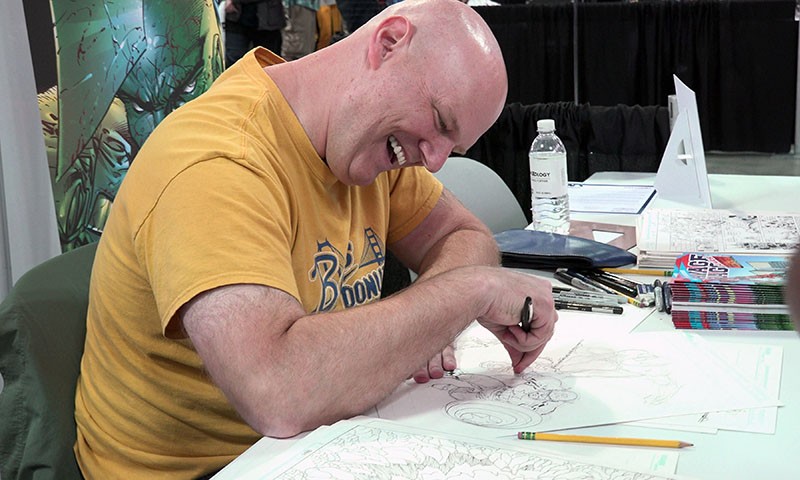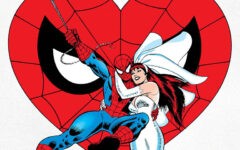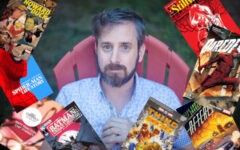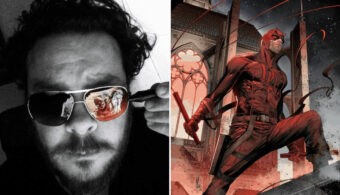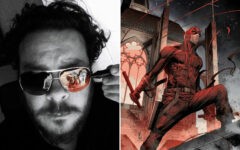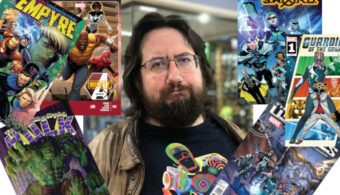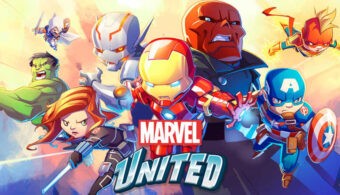Erik Larsen, in the 90s, before becoming one of the founders of Image Comics, for which he has been continuously publishing the series dedicated to Savage Dragon since 1992, was one of the leading authors of Spider-Man. In this interview we retrace with him that period of his career, from the importance of the birth of Image to his work on the Webcrawler which made him known to the general public.
Welcome to Lo Spazio Bianco, Erik!
In 2022 Image Comics celebrates 30 years of life: its birth was an epochal turning point for American serial comics. You were one of the seven “founding fathers” of the publisher: three decades later, what are your thoughts on this experience that continues today, what do you remember about those old days.
Mostly I remember having a good time hanging out with friends and being part of something which was genuinely positive. It was positive for the industry and for creators’ rights and the audience was extremely enthusiastic about the comics, our company and the work we did. There was a time when it got pretty crazy and we had to be ushered around like we were the Beatles, which was pretty strange, but comic book fame isn’t like real fame. With real fame–you can’t go anywhere or do anything. With comic book fame you can be the most famous person in the world in one room but if you step out that door into the real world–nobody knows who you are and you can shop for shoes without being recognized. It’s a fun kind of fame, because you get a taste of fame without it becoming unbearable. Mostly I remember the enthusiasm of the group and the love from the fans.

Looking back, is there anything you would do differently? And what are your thoughts on the latest evolution of the publisher?
If you live any life differently you’re going to make different choices just to spice things up. I don’t have a lot of regrets. Maybe I’d have the Savage Dragon story in Image-X month have a different issue number just to keep things clean and simple–but beyond that, there’s not much. I tend to look forward instead of back. I can wish that I made my earlier deadlines, and I do, and that I didn’t say this or do that but what’s done is done. I can’t do anything about the past. I can only effect the future. In days of old, we all voted on every project and that just got too cumbersome to continue. Having the publisher make those decisions was a good call.
How do you see the American comics industry today and, in the face of the upheavals that occurred in the last two years due to the pandemic that have closely affected also the world of comics, what and how do you think the future of this industry could be?
As crazy as it sounds and as counterintuitive as it may seem–sales went up during the pandemic. More people got back into comics during lockdown. I think a lot of people reevaluated their lives during this time and came to the conclusion that life was better when they were reading comics. I think things will change, certainly, but things always change.

2022 also saw the celebration of the 40th anniversary of Savage Dragon, a character that has accompanied you since your beginnings in the industry. What is the secret to keep this character alive after decades of stories and adventures?
I don’t know that there is a secret, per se. Certainly a lot of readers seem to enjoy a book set in real time where characters age and grow and there are repercussions and real consequences. I think part of its appeal is that anything can, and does, happen.
If I’m not mistaken, you’ve written all the stories starring Savage Dragon except one. Once you retire (of course let’s say in 40 years!), would you like someone else to carry on the adventures of your character or are you more of a Hergé type who wanted Tintin to die – from a new stories point of view – with him? Have you ever thought of expanding the universe of Savage Dragon involving other creators (like the Spawn Universe right now, just to make an example)?
I’ve written every Savage Dragon story that matters, really, I don’t really count the one from Image-X month. Honestly, once I’m dead, I stop caring. If my kids want to license the character or sell him or otherwise whore him out–I really don’t care. I have no desire to control my creations from beyond the grave. If a bunch of people wanted to do something with the character after I kicked the bucket and my heirs could benefit from that–that’s fine. As far as expanding my universe–I have done that at times and I may do it again. It really comes down to story. I don’t like making product for the sake of product. If I have a story to tell–that’s another story, but I’m not going to add another title just to have another title. I’m doing Savage Dragon. I’m doing Ant. That’s two books. That’s enough for now.
Looking back, how has your character and the universe you created around him evolved? And, above all, has this evolution surprised you by taking you in directions you hadn’t foreseen?
Of course it’s evolved. Time marches on. My characters age and change is a big part of that. Savage Dragon himself died in Savage Dragon #225. His 25-year-old son is the main character now. And while I had initial plans–I’ve burned through those a couple decades ago. So much of it is unforeseen. But it’s not as though characters act out on their own. I’m still in control here.
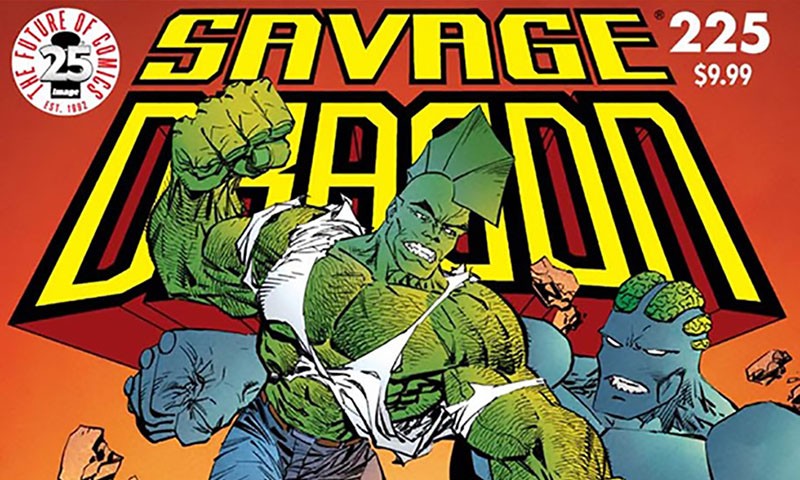
Through Savage Dragon, you have had the opportunity to read and interpret contemporary US, with stories that are very political. And how do event from our world affect your stories and the evolution of your character?
I do try to keep things current but that’s not always simple. The pandemic has really screwed things up to some extent because, as an artist, I’d prefer seeing characters’ emotions–and that means seeing their faces. That’s not so easy if everybody is wearing a mask. Mostly I can just touch on current events without doing a deep dive. Some of the politics stuff can get a bit heavy-handed. I did a Trump story a few years back where almost every line of dialogue mouthed by his supporters was literally pulled from actual online Trump supporters and most of them were modeled after actual Trump supporters and Trump himself didn’t utter a word and it still managed to ruffle a few feathers. Mostly I just acknowledge current events as a way of putting a timestamp on it and saying to the readers that this event took place at this time. So, when characters are going to a movie–it’s a real movie that came out at a real time.
In 2022 there was also the 60th anniversary of Spider-Man. In the ’90s you were one of the main and most iconic illustrators of the character. What do you remember from your very first story of the character?
My very first was a fill-in during the Gang War storyline and it was a rush job. They needed it turned around in a couple weeks and they contacted me. It was densely plotted with a lot going on and there wasn’t a lot of space to play around. In retrospect, it was not a strong issue. That was Amazing Spider-Man #287, for those keeping track at home.
And more generally, what do you remember of that period that, in some ways, redefined the character?
I just tried to have fun with it. It was great to have been able to draw most of Spider-Man’s major foes. I was happy to have had the opportunity. My goal was to build back better. Some of these characters had not been treated with a lot of respect and I wanted to restore them to their former glory.

What is for you the most fascinating element of Peter Parker and Spider-Man?
I don’t know about fascinating–but I like his sense of responsibility, his strong morals and the love he has for those he holds dear. Plus, he’s a funny character. I liked writing his as a guy performing standup.
What were the sequences and moments that you enjoyed the most while drawing the character?
I liked retooling Dr. Octopus and making him back into a heavy. He’d become a ineffective fat guy in tights and I tried to turn him into something like a gangster. I liked drawing him and Spider-Man mixing it up. There’s a shot of Spider-Man wrapped in Dr. Octopus’s arms that I thought worked out rather well. The Sinister Six stories in general were a lot of fun.
 Another character that is inextricably linked to your work on Spider-Man is Venom, of which you have defined some characteristics that have remained unchanged since then. In some of your interviews, however, you have described your experience drawing the character as ambivalent. How has your perspective on the character and your work on him changed over time?
Another character that is inextricably linked to your work on Spider-Man is Venom, of which you have defined some characteristics that have remained unchanged since then. In some of your interviews, however, you have described your experience drawing the character as ambivalent. How has your perspective on the character and your work on him changed over time?
He’s a pain in the ass to draw in pencil form, because filling in those blacks is such a pain in the ass. Post-Spider-Man, I’ve come to enjoy drawing the character in convention sketches because I can just slop in heavy blacks with a pen or brush. I still don’t find Venom’s story at all compelling–Eddie Brock’s motivation is weak and the symbiote’s motivation is even weaker–but he is visually compelling and he’s fun to draw.
Besides Spidey and Venom, which was the character you drew with the most interest and the one that for you is one of the most important of the stories you made?
Likely Dr. Octopus because he had been so badly mistreated. My goal in general was to make these characters as unique and compelling as they could be. Flash Thompson had curly hair during Ditko’s run and I restored that. I tried to nudge every character toward how they were envisioned and then expand on that. Most characters have a pretty distinctive look when they were created but they can lose that over time with successive artists looking at the artist before them (although it’s the opposite with Venom, as each artist tries to top the guy before them). Tarantula was another character I liked. The original version was one of a few new villains introduced when I was a kid, so I have an affinity for him. I wanted to make him look like a badass.
Thanks for your time, Erik.
Interview carried out via email in March 2022
Erik Larsen
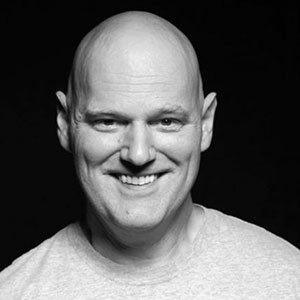 Erik J. Larsen (Minneapolis, 1962) is one of the co-founders of the independent publishing house Image Comics (1992), of which he is still a partner and of which he was the publisher between 2004 and 2008 and is now the financial director. He has published his works for Image Comics with his own Highbrow Entertainment brand, which also includes the comics of his most famous and long-lived character, Savage Dragon, of which he has been creating a regular series uninterruptedly since 1993.
Erik J. Larsen (Minneapolis, 1962) is one of the co-founders of the independent publishing house Image Comics (1992), of which he is still a partner and of which he was the publisher between 2004 and 2008 and is now the financial director. He has published his works for Image Comics with his own Highbrow Entertainment brand, which also includes the comics of his most famous and long-lived character, Savage Dragon, of which he has been creating a regular series uninterruptedly since 1993.
He made his debut as a professional author in the 1980s on the Megaton series and, thanks to Jim Shooter, he then got his first job for a major publishing house, Marvel Comics, where he stood out for his Spider-Man stories and with which occasionally returns to collaborate. He has also worked for AC Comics and DC Comics.
(source Wikipedia)



